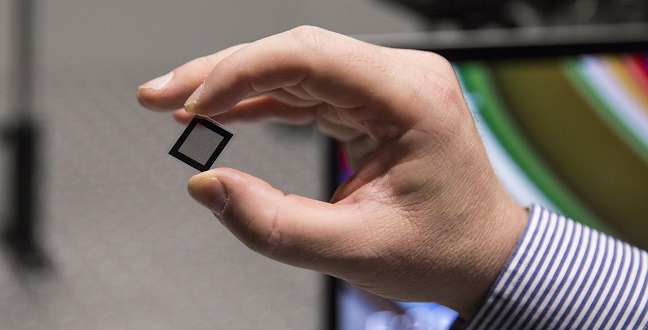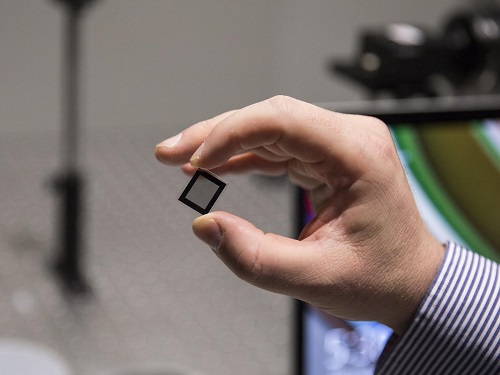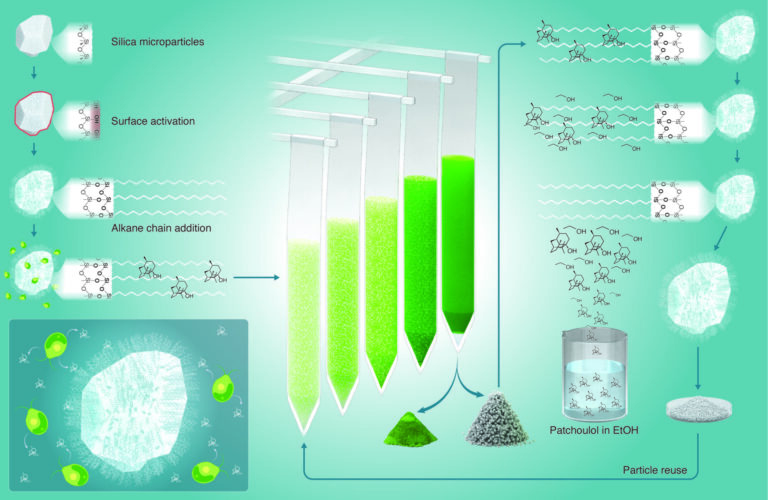Bioscience
Driven to diffraction
Optical elements that diffract light could lead to smaller and more powerful cameras.


KAUST is developing new diffractive optical elements that can be printed on to small, thin substrates.
© 2016 KAUST
As anyone with an interest in photography will know, to get features such as a powerful zoom, you usually need a big camera. The reason is that most cameras rely on refraction, whereby the light passing through lenses slows down and changes direction. Focusing this refracted light requires a certain amount of space.
A promising route to smaller, powerful cameras built into smartphones and other devices is to design optical elements that manipulate light by diffraction—the bending of light around obstacles or through small gaps—instead of refraction.
Wolfgang Heidrich, professor of computer science, and colleagues from the University’s Visual Computing Center and the University of British Columbia (UBC) in Canada are at the forefront of developing new diffractive optical elements (DOEs) that can be printed on to small, thin substrates. The team combines their carefully-designed DOEs with advanced computational techniques that can greatly enhance the images produced by such small optical devices.
Heidrich came to KAUST in 2014 from UBC, where he previously developed very high contrast displays for television sets.
“We developed the first consumer-ready display technology that had a major computational component in the sense that the hardware itself was not useful without substantial computation,” he said. “The target image would be sent to the device, and then the device would have to perform some fairly sophisticated algorithms on the image—in real time!—to produce the best image contrast. It really instilled in me the need for hardware-software co-design, where you develop optics, electronics and algorithms at the same time so that they fit together in the best possible way.”
Heidrich and co-workers have recently applied the same approach to computational imaging for cameras. Chromatic aberration, a major problem they are addressing, will be familiar to anyone who has played with triangular prisms to produce a rainbow—different wavelengths change direction by varying amounts when they are refracted by lenses, resulting in incorrect color distributions in images.
Chromatic aberration is an even greater problem when light is manipulated by diffraction, so DOEs suffer a loss of color fidelity and blurring that depends on the color distribution of the incoming light. To combat this, Heidrich and his co-workers designed a thin, lightweight DOE called a diffractive achromat to balance the focusing contributions of different wavelengths1. Their results from testing this innovative new component were published in ACM Transactions on Graphics, the top journal destination for computer graphics studies.
“In a regular DOE lens, the focus will be near-perfect for a single design wavelength and progressively blurred as you move away from that design wavelength,” Heidrich explained. “The diffractive achromat sacrifices a little bit of sharpness for the design wavelength in exchange for more sharpness at all other wavelengths. Any remaining blur can then be removed computationally.”
The researchers applied the same combination of cutting-edge optics with computer algorithms in a recent study published in Scientific Reports that could lead to extremely small zoom lenses2. They used computational algorithms to design two DOEs with particular shapes so that when they are placed on top of each other, they represent a diffractive lens with a specific focal length.
Then comes the most clever part, as Heidrich noted, “As you rotate the two DOEs relative to each other, the focal length or any other parameter of the optical system can change smoothly. One obvious application is to produce zoom lenses that do not require the lens barrel to move in and out of the camera for zooming.”
Heidrich said the active research environment at KAUST has been invaluable for pursuing his recent goals.
“I have been able to assemble an interdisciplinary team for more ambitious projects that take our hardware-software co-design to the next level. What’s more, all our diffractive optical elements were built in the KAUST Nanofabrication Core Lab, which allowed quick turnaround times for experiments,” he noted.
Computational imaging is still in its infancy and provides many avenues that Heidrich and his colleagues hope to explore in coming years. Perhaps most excitingly, because DOEs are so thin, they don’t absorb much energy from light as it passes through. This means that DOEs could in principle be used to manipulate any part of the electromagnetic spectrum from radio waves to gamma rays.
References
-
Peng, Y., Fu, Q., Heide, F., & Heidrich, W. The diffractive achromat: full spectrum computational imaging with diffractive optics. ACM Transactions on Graphics 35, 31 (2016).| article
-
Heide, F., Fu, Q., Peng, Y. & Heidrich, W. Encoded diffractive optics for full spectrum computational imaging. Scientific Reports 6, 33543 (2016).| article
You might also like

Bioscience
Hidden flexibility in plant communication revealed

Bioscience
Harnessing the unintended epigenetic side effects of genome editing

Bioscience
Mica enables simpler, sharper, and deeper single-particle tracking

Bioengineering
Cancer’s hidden sugar code opens diagnostic opportunities

Bioscience
AI speeds up human embryo model research

Bioscience
Sex chromosome overload sparks to a common developmental faultline

Bioscience
Super fungi survive extreme Mars-like environments

Bioengineering



